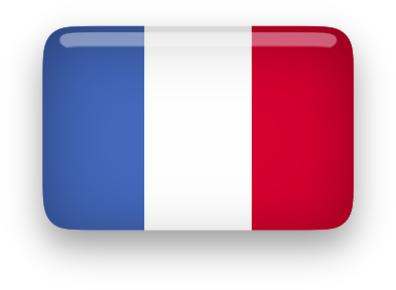


2023
Jan
Feb
Mar
Apr
May
Jun
Fougères - Sept
2022
Jan
Feb
Mar
Apr
May
Jun
Jul
Aug
Sep
Oct
Nov
Dec
2021
Jan
Feb
Mar
Apr
May
Jun
Jul
Aug
Sep
Oct
Nov
Dec
2020
Jan
Feb
Mar
Apr
May
Jun
Jul
Aug
Sep
Oct
Nov
Dec
2019
Jan
Feb
Mar
Apr
May
Jun
Jul
Aug
Sep
Oct
Nov
Dec
2018
Jan
Feb
Mar
Apr
May
Jun
Jul
Aug
Sep
Oct
Nov
Dec
2017
Jan
Feb
Mar
Apr
May
Jun
Jul
Aug
Sep
Oct
Nov
Dec
2016
Jan
Feb
Mar
Apr
May
Jun
Jul
Aug
Sep
Oct
Nov
Dec
2015
Aug
Sep
Oct
Nov
Dec
Search RuthAndJohn.com NOTE: click on the link then put your search words inside the quotes on Google

Kitties
Charlie has been a box chewer almost from day one but recently the other two have adopted the habit.
Sweeping cardboard bits is now a regular routine. The boxes keep them happy and stave off many of their
kitty crazies in the middle of the night. We keep the chewed up boxes for a few weeks because the kitties
like them so much but eventually we recycle them. When we do the kitties quickly make another chewed up box.
I have a feeling they might not outgrow this.
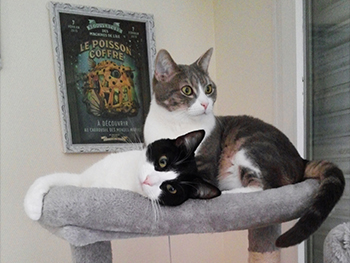
|
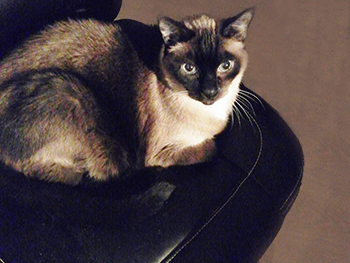
|
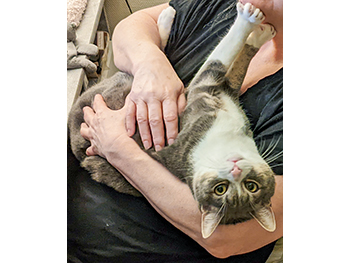
|
| Charlie and Buster in the kitty tree | Tommy in John's office chair | Buster, please be normal? Nope! |
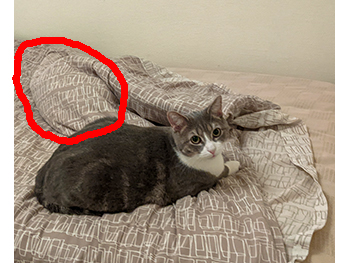
|
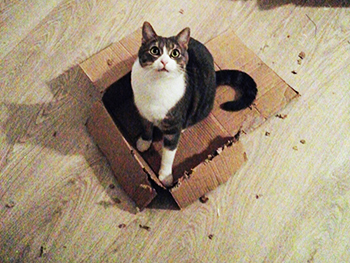
|
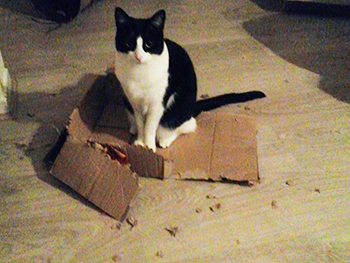
|
|
Buster guarding Charlie as he sleeps under the duvet. |
Buster in the chewed box. | Charlie in the chewed box. |
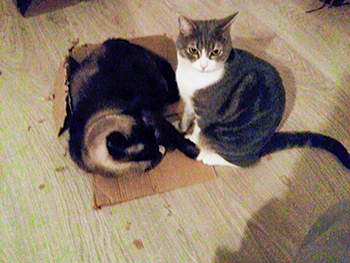
|
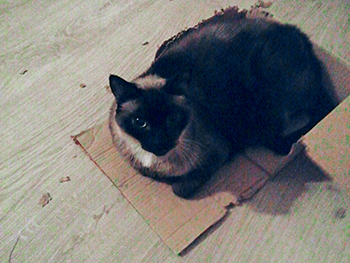
|
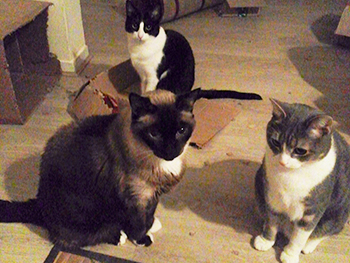
|
| Tommy and Buster in the chewed box. | Tommy in the chewed box. |
All three boys telling John not to throw away the chewed box. |

Archaeology today in Rennes.
Jan 18 - John and I were in centre ville Rennes today getting my PCR test and we saw some digging in the square between
the Opera House and the City Hall. You can see the flat stones (image 3) that must have been a previous surface layer of
the square in the middle ages. In the lower right hand corner you can see the curving cobblestone pattern of
the present surface. Image 6 (the loose items on top of the cobblestones) looks to be some medieval building parts that were excavated.
I posted some of John's photos and some info about the area, the dig and one earlier dig on Facebook.
Our friend Alley had also been there and she asked me if we had seen the skeletons. We hadn't, but John
went back and took photos of the last skeleton before it was taken away, Alley chatted with one of the
archaeologists briefly. By then all the skeletons had been removed but she got to look around the dig and talk to the science guy.
NOTE: Some of the following articles are in French. Right click to translate The video is in French and there are no captions. just French
audio. The video images, though, are impressive.
"Place de la Mairie in Rennes (city hall), the construction site preceding the planting of trees brought to light four old graves . These bones
will be subjected to the technique of carbon 14 dating operation. Difficult, for the moment, to say if the bones belong to men or women."
This article has more pics of the skeletons: What do we learn from the graves discovered at the foot of the town hall of Rennes
John went back the next day and took more photos before the archaeologists and excavators removed the last of the skeleton bones.
It's not obvious that the archaeologist/excavator has a baguette in hand in the 4th image below but John was there and saw him
waving around a baguette sandwich and conversing with passersby while standing in an excavated grave
(note the skull and bones collection bags right behind his elbow).
There's been much more digging these last few years in Rennes due to a development boom, including building a second metro line.
I gave a presentation about this recent dig to the STEM group in Eugene. You can read the content of that presentation,
see many more photos and learn about earlier and massive archaeological finds in Rennes using this link
One of my STEM friends, Bob, shared some VERY COOL info this month about YouTube videos showing a wide variety of specialists
explaining one concept in their field in 5 levels of difficulty
(child, teen, college student, grad student, expert).
There are 16 episodes to Season 1. Each is about 20 minutes and explains all 5 levels in that time.
Check it out - the child ones make great intros to the subjects about which you may know little or nothing.
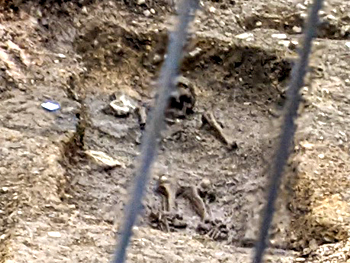
|
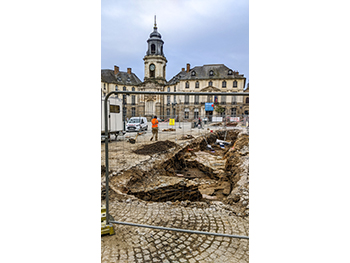
|
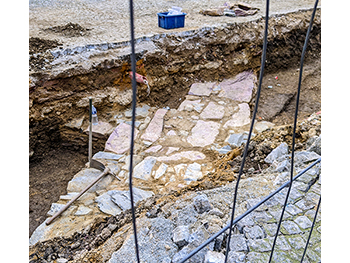
|
| One of the excavated skeletons |
The excavations are in the Place de la Mairie. The city hall is in the background. |
The stones in the center were from the medieval square. The cobblestones in the lower right are from present day. |
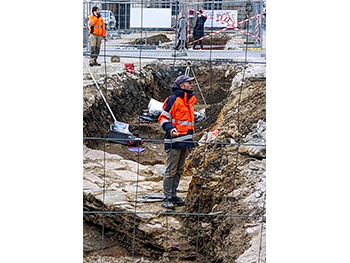
|
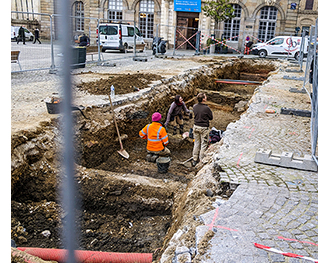
|
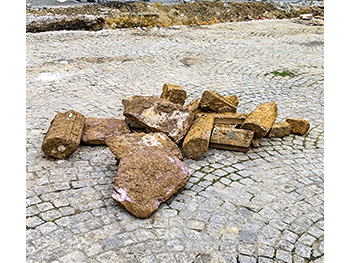
|
| This archaeologist was eating a baguette sandwich and talking to passersby. | The archaeological finds were discovered when trenches were dug to plant trees. |
Parts of a medieval building that were found buried on the site. |
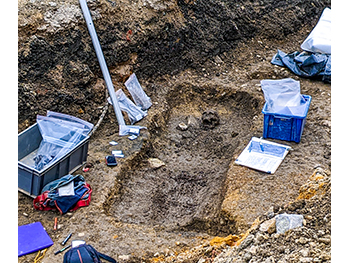
|
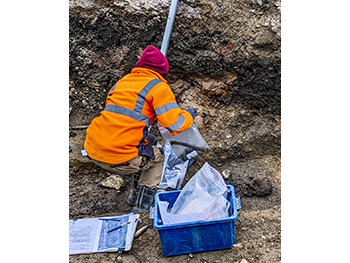
|
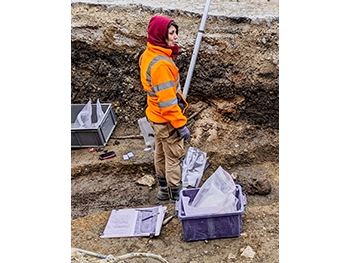
|
|
The bones of this skeleton were recovered, except for the head. |
The bones were placed in plastic bags. | An interesting job. |
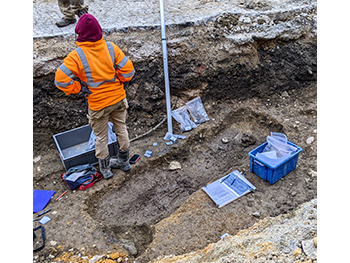
|

|

|
| Every step was documented. |

Saint-Germain church
Saint-Germain is a parish church of Rennes located very close to the dig where the 5 skeletons were found. John took
some time to go inside and take a few photos. Formerly parish of the rich merchant-mercers then of the parliamentarians,
the building is of flamboyant Gothic style. It was erected for the most part from the 15th century to the 17th century.
It retains the oldest stained glass window in the city, from the sixteenth century (south flank), recomposed in 1860.
The stained glass window remained intact throughout the building. Listed as a historical monument on May 25, 19095,
it brings together various panels relating to the life of the Virgin, the life of Saint Anne and Saint Joachim (mother and father of Mary),
the Passion and that of Saint John the Evangelist (after The Golden Legend of Jacques de Voragine).
One of the oldest stained glass window in Rennes which is in Saint-Germain has a funny back story.
The 16th century stained glass window was a potential target for vandals during the French Revolution.
To protect the glass church officials had it removed from the
Master Window of the Choir
and piled in a barrel. The disassemblers were rushed and didn't draw the image or its coloring so when the pieces were found by chance
in the nineteenth century the reassemblers couldn't discern where the pieces went. So now that stained glass is an
interesting piece of abstract art in the St Germain church.
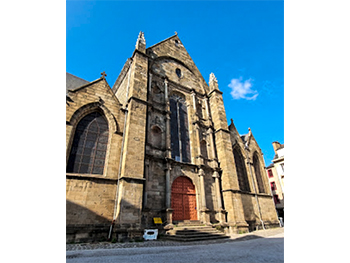
|
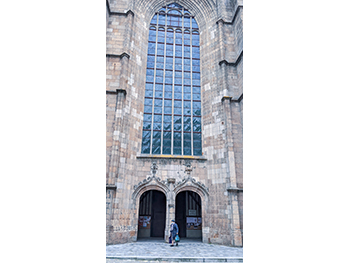
|
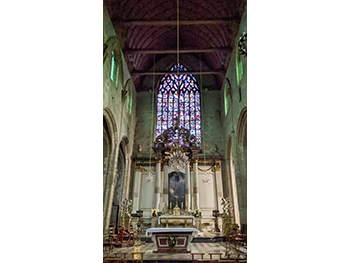
|
| 16th Century church of St. Germain | The side entrance to St. Germain | Interior - central aisle |
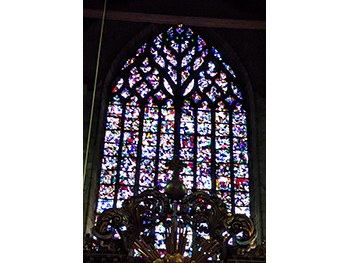
|
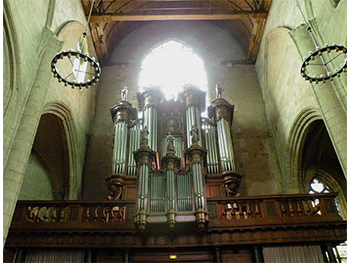
|
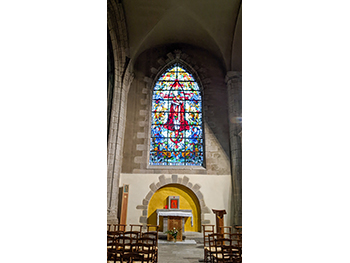
|
| The "puzzle piece" stained-glass window | St. Germain's amazing organ | One of the more modern stained-glass windows |
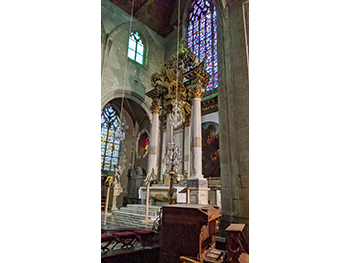
|
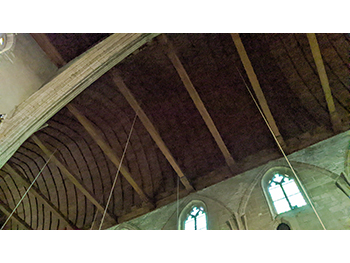
|
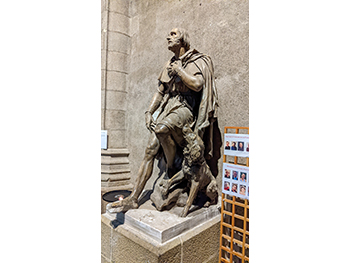
|
|
The high altar and marble columns from the Louis XVI period |
Barrel vault ceiling | One of the many statues in St. Germain |
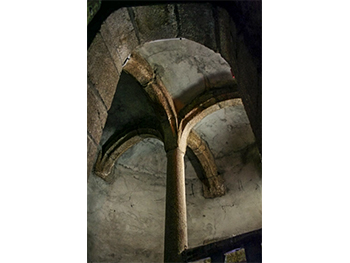
|
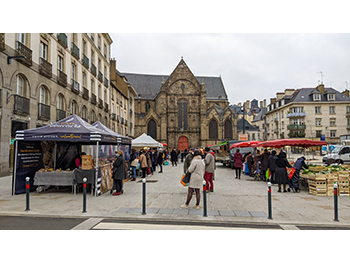
|
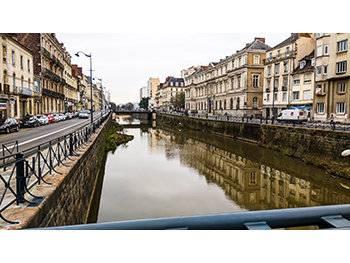
|
| The entrance to the staircase of the bell tower |
An open market with St. Germain in the background |
La Vilaine river flowing through Rennes |

Our Neighborhood
Looking out our kitchen window this morning we saw Mariachis singing "Happy Birthday" in French.
I think they were part of a birthday party entertainment in Parc Oberthur, our next door park.
Here's a link to everything you want to know about French birthday socials.
My favorite birthday song is still the La Birthday Song
from Blue Mountain ecards.
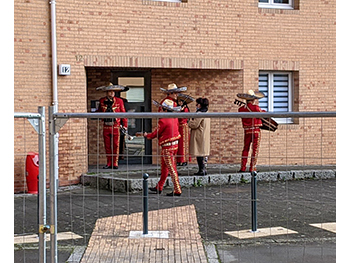
|

|

|
|
We only saw the mariachis after their surprise concert in the park. |

French Presidential campaigns
The Presidential campaigns are well underway in France. Elections are in June. President Macron is running again.
Liberals haven't organized behind one candidate
again and Marie LePen's followers (including her niece) are defecting
to far right candidate Éric Zemmour. The current mayor of Paris, Anne Hidalgo was chosen by the Socialist Party (PS) to be its candidate for the presidential election.
After the popular Primary on January 30, the left is at an impasse.
The victory of Christiane Taubira, Sunday January 30, at the end of the popular Primary, does not solve the problems of the left,
which is still also divided a few weeks before the first round of the presidential election.

Molière
On January 16 France began a year of events to mark the 400th birthday of Molière,
the nation's most illustrious - and still popular - master of the stage and satire.
Baptised on January 15, 1622, and probably born a day or two before, Molière - real name Jean-Baptiste Poquelin - remains as central to
French culture as Shakespeare is to the English-speaking world.
When the French refer to their native tongue, it is as the "language of Molière". Many of the celebrations will
be staged in places that marked his life as an actor, company director and playwright, but above all at the
Comedie-Française, created by King Louis XIV in 1680, seven years after Molière's death.
John was in Tartuffe, a play by Molière,
when he was in high school in a Catholic school. The play is about a hypocritical priest.

Remembering the Revolution
France remembers the French Revolution. On 21 January in 1793, King Louis XVI was executed by guillotine in Paris
after being convicted of treason. A turning point during the French Revolution, the execution of a king by his
subjects was a transformative moment for European history.
Article, drawings, editorial cartoons

Covid situation in France as of January 31, 2022
The global incidence rate in France, as of Thursday 27 January 2022 (consolidated data) is slightly decreasing and
reaches 3,639.91 which is still far above the alert threshold of 50.
Covid in other European countries
Boris Johnson ended Covid response Plan B
including mask mandates, work from home recommendations, health pass,
travel restrictions (for vaccinated travelers) and more.
Spain is also evaluating plans to treat Covid as flu
but WHO and CDC say it's too soon to treat Covid as endemic because some mutations have been significant and one or
more future variations could be more deadly and contagious than is Omicron.